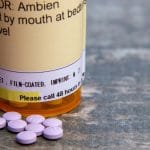Zolpidem is a sedative-hypnotic medication sold under the brand name Ambien. It is prescribed for short periods of time as a sleep aid when other, non-drug treatments for sleeping problems aren’t effective.
While nonbenzodiazepine sleeping pills, also called z-drugs, are considered to be less habit-forming than benzodiazepines, they can still be misused leading to physical dependence, addiction, and withdrawal when you stop use.
Ambien Dependence
Ambien alters the body’s neurochemical balance, causing the feelings of relaxation and drowsiness that make it a useful drug for the short-term treatment of insomnia.
However, if the body is routinely exposed to the drug it will rapidly begin to adjust and adapt to the medication, resulting in:
- physical dependence
- tolerance
- withdrawal
Any Ambien use, including use as prescribed, can lead to the development of dependence and tolerance starting in as little as two weeks.
However, these effects tend to develop more rapidly and more severely when the drug is used over a long period of time and/or taken in high doses.
Dependence, tolerance, and withdrawal symptoms are also common features of Ambien addiction.
Ambien Withdrawal Symptoms
Because it acts as a central nervous system depressant, symptoms of Ambien withdrawal generally involve over-active physical and mental reactions.
Ambien withdrawal symptoms include:
- agitation
- anxiety
- convulsions
- delirium
- fever
- high blood pressure
- insomnia
- irritability
- nausea and vomiting
- panic attacks
- rebound insomnia
- shakiness
- stomach cramps
- seizures
- sweating
- uncontrollable crying
Ambien Withdrawal Severity
The specific symptoms any one person experiences during Ambien withdrawal, and their severity, may be impacted by numerous factors.
Factors that affect withdrawal severity include:
- length of Ambien use
- use of Ambien in low or high doses
- overall physical health
- age (older adults are more prone to severe withdrawal symptoms)
- co-occurring medical conditions, including mental health problems
- use of Ambien on its own, or in combination with alcohol, opioids, cannabis, etc.
Because the effects of Ambien withdrawal can be uncomfortable, dangerous, or even fatal in rare cases, it is strongly recommended that those attempting to stop taking Ambien speak to a healthcare professional about their options, including tapering and medical detox.
Ambien Withdrawal Timeline
While everyone’s experience with withdrawal is unique, a common timeline for the process includes:
1-2 Days After Last Dose
Ambien has a short half-life of 2 hours and is eliminated from the body after around 11 hours.
This means that if the drug is discontinued abruptly, you should expect to experience withdrawal symptoms starting 1-2 days later as the medication is fully expelled from your system and its effects wear off.
These initial symptoms are likely mild but can sometimes involve rebound insomnia and severe fatigue.
3-5 Days
Severe withdrawal symptoms increase and peak around this time. Illness, confusion, memory loss, mood swings, and panic attacks are common.
In cases of addiction, Ambien cravings may also occur.
6-14 Days
After peaking, withdrawal symptoms will likely decrease and fade away as the body adjusts to the drug’s absence. Sleeping should become easier as well, though some psychological symptoms may persist after this period.
Medical Detox, Tapering, & Addiction Treatment
Medically-assisted detox services exist to help people discontinue drugs safely, comfortably, and with close medical supervision. Both inpatient and outpatient detoxification services are widely available.
In the case of Ambien detox, tapering schedules are often recommended, as lowering one’s dosage over time can often minimize or entirely avoid the harmful withdrawal symptoms that come with quitting the drug cold-turkey.
Once detoxification is complete, participants can move forward with other addiction treatment programs as recommended.
Inpatient Treatment
Inpatient or residential treatment is the most intensive option for treating substance abuse and drug addiction.
Participants in inpatient programs move into a treatment facility for an extended period of time while participating in a variety of treatment options and interventions. This provides an excellent setting for various types of behavioral therapy.
Inpatient treatment is also a good setting for dual diagnosis treatment, which can provide integrated treatment for other physical or behavioral health conditions that may have contributed to a person’s abuse of Ambien.
This can include treatment for other substance use disorders, as well as treatment for sleep disorders.
Outpatient Treatment
Outpatient treatment can vary in intensity, but offers participants a larger degree of freedom to continue living at home while commuting to scheduled treatment events.
Outpatient programs often focus on counseling, both individually or in groups. This is often paired with participation in peer support groups, giving participants support from others who are also recovering from various forms of substance abuse and addiction.
Find Treatment Today
If you or a loved one struggle with chronic Ambien misuse or addiction, please contact Northeast Addictions treatment Center today.
Sources
Written by
Northeast Addition Editorial Team
©2024 Northeast Addition Center | All Rights Reserved
This page does not provide medical advice.



